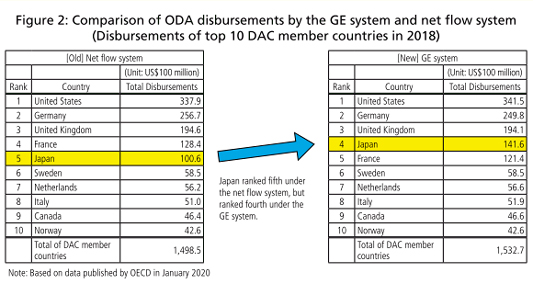ODA Topics 1
Introduction of the Grant Equivalent System in the ODA Calculation
Achieving greater accuracy in evaluating Japan’s donor efforts through the new system
The Development Assistance Committee (DAC) of the Organisation for Economic Cooperation and Development (OECD) collects and publishes data on the internet and other media, based on the reporting from member countries with regard to the actual volume of ODA extended by each member country in a year. DAC also establishes a set of rules on what constitutes ODA, and how member countries calculate and report actual ODA flows to DAC, etc. The “Grant Equivalent System (GE system)”* has been introduced as the calculation method from 2018 statistics for actual ODA flows, replacing the previous “net flow system.”
A notable characteristic of this new system is its method of calculating the total disbursement of loan aid (such as ODA loans). Under the net flow system, which was the previous calculation method, newly disbursed amounts were calculated as positive, but on the other hand repaid amounts were calculated as negative. This means that when repayment is eventually completed for an ODA loan project, the amount disbursed for the implemented project statistically becomes zero as the positive and negative amounts offset each other.
In contrast, the new GE system focuses on how soft the terms of loan are for the loan aid provided. In addition to the amount of loan provided, it also takes into consideration elements including the terms of loan, such as interest rate and repayment period, and whether the aid is directed toward least developed countries and low income countries that have a greater need for assistance. Thus, out of the gross disbursement of loan aid, the new system calculates the grant equivalent as actual ODA disbursements. For this reason, unlike the previous system, the ODA disbursements do not decrease even when an ODA loan is repaid. Under the GE system, the more concessional the terms of loan are, the greater the amount that is calculated as the grant equivalent. Hence, the system provides a more accurate reflection of donors’ efforts (see Figure 1).

As Japan provides large amounts of loan aid to developing countries on favorable terms, the calculated amount of actual ODA disbursements in 2018 increased by approximately 40% when compared with the amount calculated using the previous net flow system (see Figure 2). As a result, Japan, which would rank fifth among DAC member countries on the net disbursement basis, ranked fourth on the grant equivalent basis. Similarly, with regard to the ratio of ODA disbursements to Gross National Income (GNI), Japan’s ratio, which would be 0.20% on the net disbursement basis (20th among the 29 DAC member countries), rose to 0.28% (16th) on the grant equivalent basis.

In recent years, various discussions have been held in the DAC on the so-called “modernization of ODA,” with a view to improving ODA to align with the present era, and Japan is also actively participating in these discussions. The introduction of the GE system was decided at the DAC High Level Meeting in 2014, and could be described as one of the achievements of the “modernization of ODA.” At the DAC meetings, there are some cases when opinions differ greatly among member countries depending on the point of issue, and some member countries face difficulties in building consensus. However, since the decision was made in 2014, technical problems concerning the specific rules of the calculation methods for the new system have been resolved one by one through discussions among the member countries, as they moved toward the full-scale adoption of the GE system from 2018. Trial reporting of ODA figures based on the new system to the DAC also began from 2015.
The situation surrounding development cooperation is significantly changing with the times. In order to effectively address the current challenges such as contributing to the achievement of the SDGs, mobilizing resources to meet the huge demand for development funds such as for infrastructural development, and solving global issues, continuous discussions among countries and trial-and-error process are ongoing toward establishing rules and collecting data on ODA and other forms of development funds.
* Following the introduction of the GE system, Japan’s ODA disbursements calculated by the GE system are also used in the charts in this White Paper. Details are as follows:
1. Addition of the grant equivalent in the following charts: Chart I-1, Reference Statistics 2 (1) excluding disbursements for graduated countries
2. Use of the GE system for disbursements in 2018: Chart I-3, Chart I-4, Chart I-5, Chart I-6
